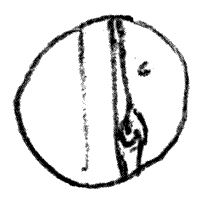
webcam image by Wingko Yung of the RASC Toronto Centre
4" f/5.4 refractor, Philips Toucam Pro (IR cut filter), 5x Powermate
taken from backyard in Richmond Hill
9:42 PM. I finished my set up on the side walk in front of my home. Conveniently, this had me and the Schmidt-Cassegrain under the big maple tree (as a dew and light shield). I targeted the largest planet between the rotting tennis court and litter-strewn east end of the tech high school. Hey! The lights are off. Huh. The sodium lights on the east end of the building were on before...
The mosquitoes did not waste time nipping at my ankles. I was hot and sweaty from earlier in the day (car repair over at Malcolm's) and now the lugging about of telescope and astronomical gear. I quickly put on my long pants and heavy socks. Then I had to immediately slow down, cool off!
I took in the view. Multiple dark cloud belt were visible despite the air turbulence. All four big moons were visible.
10:04 PM, 57% humidity, 22.2°C. The Jovian system looked really good at 110x. I can see it! I can see the large festoon. It's about 1/4 of the way along the disk, on its way to the meridian crossing. Wow! I've finally seen it. I've tried many times before. I didn't set up for break records tonight but that's a nice spin off...
10:22 PM, 56%, 22.3°. The Great Red Spot was slowly drawing closer to the meridian. When the seeing was poor, it looked like a bite mark, a semi-circle of white showing in the south side of the south belt; when the air steadied, I could see a thin dark ring around the giant storm.
When the air steadied, the view was very good. Yeh! That means I did not screw up my SCT collimation! Woo hoo!
Amazing detail showed at times, the southern hemisphere was a mottled white, the GRS was actually darker (but only slightly), a very pale tan, and the southern cloud belt was a light chocolate brown.
10:40 PM, 55%, 22.4°. Bob arrived home, parked his car, wandered across the street and asked what I was looking at. I offered him a peek. He was very impressed with Jupiter. He could see some of the details as I pointed them out.
He was also very impressed by the size of the telescope. I kept saying it was "medium." I was trying to be humble while he was reeling. I guess I should agree. Size matters.
The view was very symmetrical now. The GRS was almost in the middle.
10:44 PM. I think it was dead-centre. I couldn't tell if it was still approaching or just past centre. It must have been pretty close to the middle.
The southern cloud belt is not solid! There is a lighter white stream or band (zone) within it, about 1/3 of the way from the equator. I'm amazed that I can see this. As the gas giant rose higher, as this planet's air settled, as my 'scope reached equilibrium, the view dramatically improved.
There was an occasional breeze of wind, the air felt like it was cooling. It was refreshing. As soon as I started walking around though, I'd sweat.
10:55 PM. A gentleman from the neighbourhood was walking by. Richard introduced himself and I offered views. He was really taken aback. While he had seen pictures, this was a first for him, seeing it directly through a telescope. I love how the English describe something tremendous or fantastic, a very apropos term for astronomy: "Brilliant!" Indeed.
The two proximal moons (presumably one is Io) are drawing close to one another. Or rather, the inner one (probably Io) was moving away from Jupiter. When I started watching, it was just over a disk-width away; now it was almost 2. [Correction: inner one is Europa.]
 11: 08 PM. I noticed a small dark dot in the south hemisphere. It was above (in my orientation) the GRS, about 1 GRS-width away. It was further south than the GRS. Another storm?
11: 08 PM. I noticed a small dark dot in the south hemisphere. It was above (in my orientation) the GRS, about 1 GRS-width away. It was further south than the GRS. Another storm?11:13 PM, 54%, 22.3°. The atmospheric seeing is rock-solid. Steady, clear views of the planet persisted for moments on end. Wonderful. The northern belt is darker, more brown, then the south belt. Thinner but more turbulent. I can see it is not smooth. Occasionally, I can see other bands in the northern hemisphere.
11:26 PM. Myron, another neighbourhood wanderer from "just down the street," gesturing to the west, dropped by. He too was very impressed with the view, the detail, the immediacy. He said he had looked through many telescopes before but never seen a view like this!
Could that dark spot be a shadow? I didn't think any were predicted tonight...
11:38 PM, 56%, 21.8°. I spotted another field star, closer to the distant moon, fainter than the field star off Io.
§
This evening represented my first run with the new tripod leg cam clamps. They worked really well. Fast and easy! For both set-up and tear-down.
§
I had to review eyepiece view orientation, i.e. west-east... I turned off the drive at one point and watched how the view drifted. I wasn't sure at the time but I later verified that the view drifts to the west.
§
From the side walk, I had not oriented the telescope mount to true north. So I had to keep trimming the Declination axis through the evening... Mildly annoying. I had my compass in my pocket... Silly rabbit!





No comments:
Post a Comment